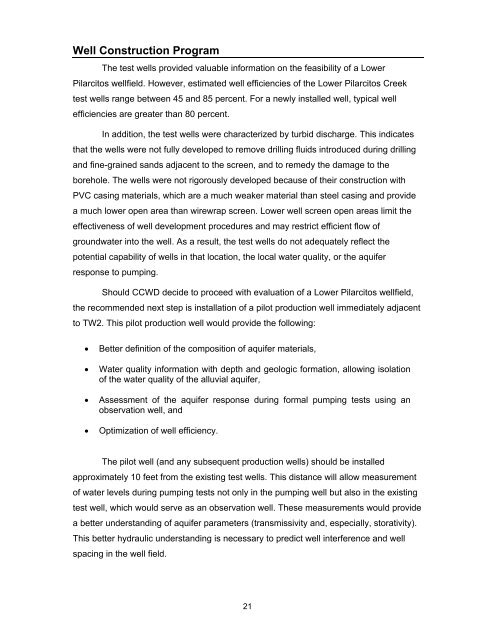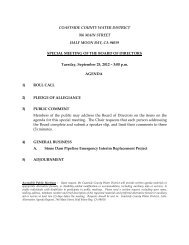Lower Pilarcitos Creek Groundwater Basin Study - Coastside ...
Lower Pilarcitos Creek Groundwater Basin Study - Coastside ...
Lower Pilarcitos Creek Groundwater Basin Study - Coastside ...
You also want an ePaper? Increase the reach of your titles
YUMPU automatically turns print PDFs into web optimized ePapers that Google loves.
Well Construction Program<br />
The test wells provided valuable information on the feasibility of a <strong>Lower</strong><br />
<strong>Pilarcitos</strong> wellfield. However, estimated well efficiencies of the <strong>Lower</strong> <strong>Pilarcitos</strong> <strong>Creek</strong><br />
test wells range between 45 and 85 percent. For a newly installed well, typical well<br />
efficiencies are greater than 80 percent.<br />
In addition, the test wells were characterized by turbid discharge. This indicates<br />
that the wells were not fully developed to remove drilling fluids introduced during drilling<br />
and fine-grained sands adjacent to the screen, and to remedy the damage to the<br />
borehole. The wells were not rigorously developed because of their construction with<br />
PVC casing materials, which are a much weaker material than steel casing and provide<br />
a much lower open area than wirewrap screen. <strong>Lower</strong> well screen open areas limit the<br />
effectiveness of well development procedures and may restrict efficient flow of<br />
groundwater into the well. As a result, the test wells do not adequately reflect the<br />
potential capability of wells in that location, the local water quality, or the aquifer<br />
response to pumping.<br />
Should CCWD decide to proceed with evaluation of a <strong>Lower</strong> <strong>Pilarcitos</strong> wellfield,<br />
the recommended next step is installation of a pilot production well immediately adjacent<br />
to TW2. This pilot production well would provide the following:<br />
• Better definition of the composition of aquifer materials,<br />
• Water quality information with depth and geologic formation, allowing isolation<br />
of the water quality of the alluvial aquifer,<br />
• Assessment of the aquifer response during formal pumping tests using an<br />
observation well, and<br />
• Optimization of well efficiency.<br />
The pilot well (and any subsequent production wells) should be installed<br />
approximately 10 feet from the existing test wells. This distance will allow measurement<br />
of water levels during pumping tests not only in the pumping well but also in the existing<br />
test well, which would serve as an observation well. These measurements would provide<br />
a better understanding of aquifer parameters (transmissivity and, especially, storativity).<br />
This better hydraulic understanding is necessary to predict well interference and well<br />
spacing in the well field.<br />
21



